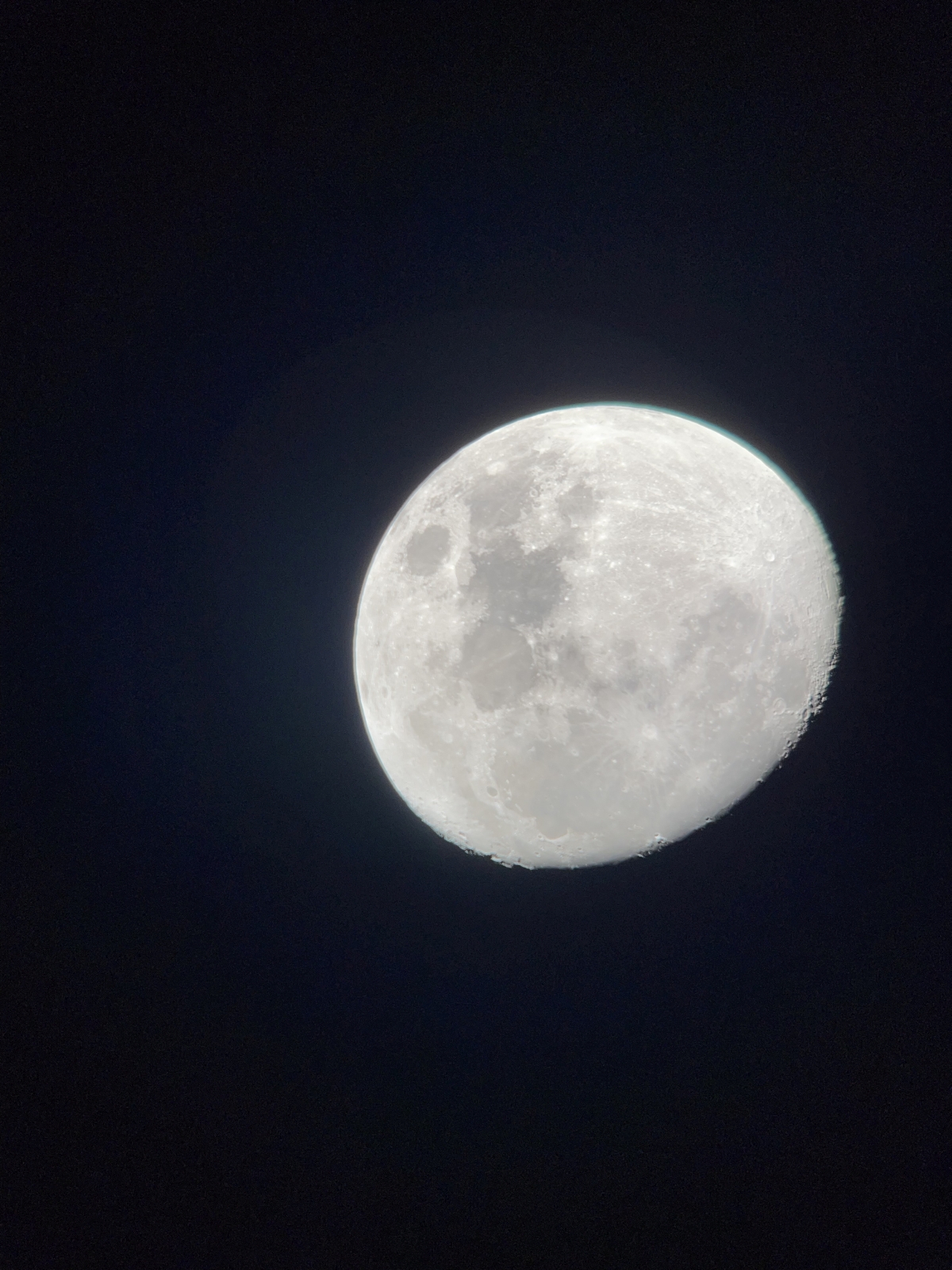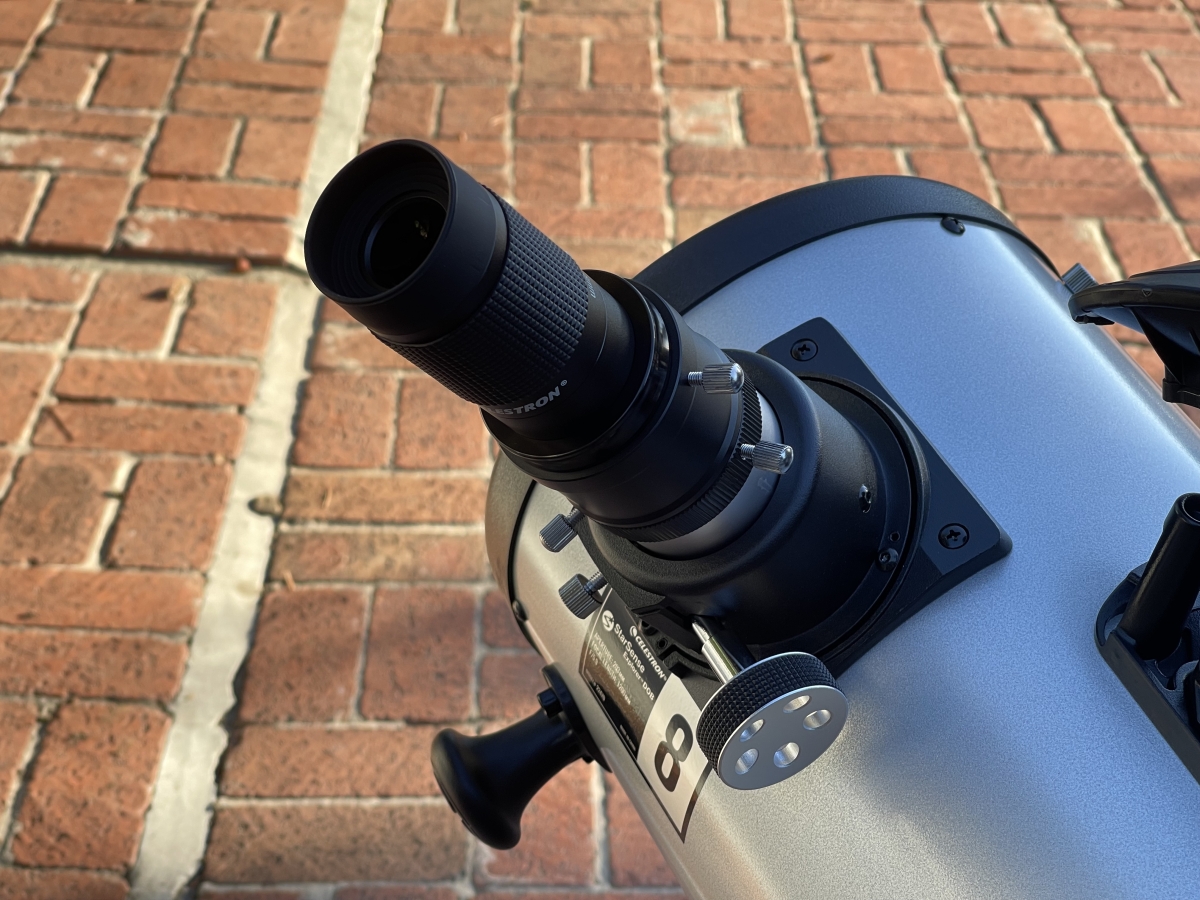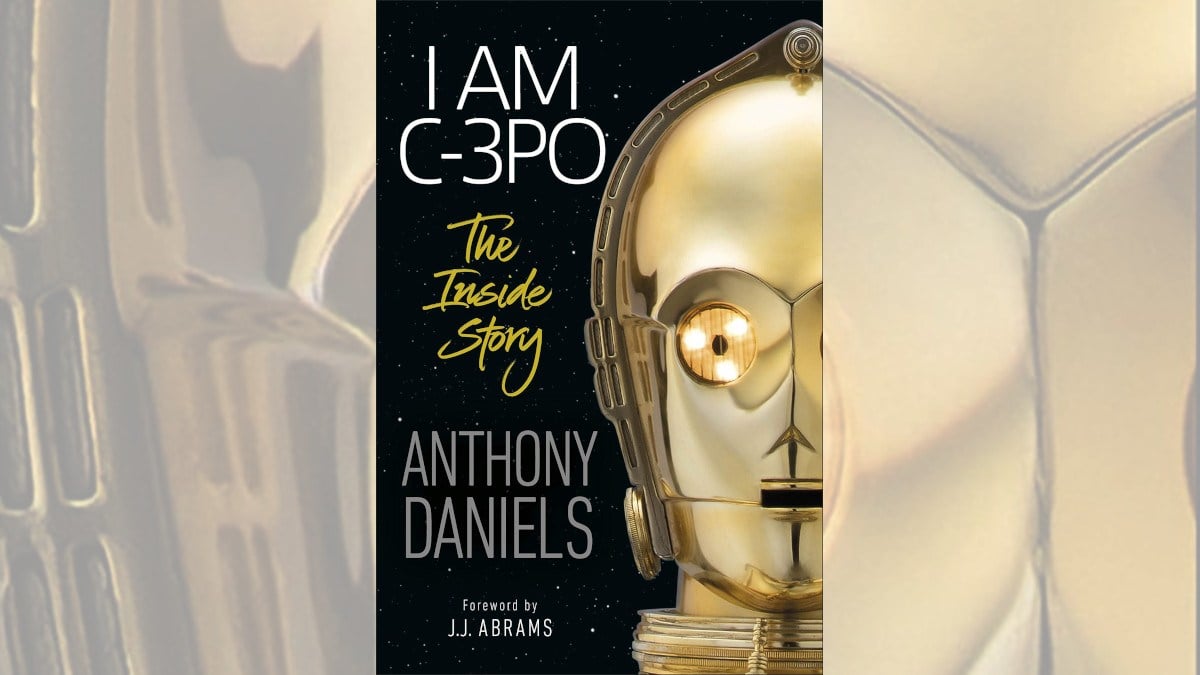The Dobsonian telescope is a design popularized by amateur astronomer John Dobson in 1965. A Dobsonian is an an altazimuth-mounted Newtonian telescope that is large, portable, and low-cost for its light-gathering power. The design is optimized for observing faint, deep-sky objects such as nebulae and galaxies.
What Is the Celestron StarSense Explorer 8″ Dobsonian?
The 8″ Dobsonian is the newest addition to Celestron’s popular line of StarSense Explorer telescopes, which uses the award-winning StarSense technology to find and track objects in the night sky. It is a Newtonian reflector with an 8″ aperture and an Altazimuth Dobsonian base.
The Celestron StarSense Explorer 8″ Dobsonian retails for $799.95, and is available directly from Celestron or from the Celestron store on Amazon.
Here are the specifications:
| Optical Tube Info: | |
|---|---|
| Optical Design: | Newtonian Reflector |
| Aperture: | 203mm (8″) |
| Focal Length: | 1200mm (47.24″) |
| Focal Ratio: | f/5.9 |
| Focal Length of Eyepiece 1: | 25mm (0.98″) |
| Magnification of Eyepiece 1: | 48x |
| Highest Useful Magnification: | 480x |
| Lowest Useful Magnification: | 29x |
| Limiting Stellar Magnitude: | 14.2 |
| Light Gathering Power: | 841x as compared to the human eye |
| Optical Coatings: | XLT reflective coatings with silicon dioxide and tantalum pentoxide protective overcoatings for primary and secondary mirrors |
| Mirror Material: | Pyrex equivalent for primary and secondary mirrors |
| Primary Mirror Thickness: | 25mm (0.98″) (approx. 1:8 thickness ratio) |
| Secondary Mirror Thickness: | 8.5mm (0.33″) |
| Minor Axis of Secondary Mirror: | 47mm (1.85″) |
| Tube Material: | Steel |
| Focuser: | 2″ Crayford focuser, includes 2″ extension tube and 2″-to-1.25″ adapter |
| Finderscope: | StarPointer™ red-dot finderscope |
| Resolution Rayleigh: | 0.68 arcseconds |
| Resolution Dawes: | 0.57 arcseconds |
| Optical Tube Dimensions: | 1117.6mm x 241.3mm diameter (44″ x 9.5″ diameter) |
| Optical Tube Weight: | 20.6 lbs (9.34 kg) |
| Mount Info: | |
| Mount Type: | Altazimuth Dobsonian base |
| Base Material: | Particle board with melamine surfaces and edge trim, CARB compliant |
| Base Dimensions: | 685.8mm x 482.6mm x 482.6mm (27″ x 19″ x 19″) |
| Base Weight: | 22.8 lbs (10.3 kg) |
| Slew Speeds: | Manual |
| Software: | Celestron Starry Night Basic Edition Software and StarSense Explorer App |
| Total Telescope Kit Weight: | 43.4 lbs (19.68 kg) |
| Included Items: | Optical tube Dobsonian Base 25mm eyepiece 2″ Crayford focuser StarPointer™ red-dot finderscope StarSense Explorer dock StarSense Explorer unlock code Eyepiece rack Collimation cap Celestron Starry Night Basic Edition Software |
Assembling the Celestron StarSense Explorer 8″ Dobsonian

The Celestron StarSense Explorer 8″ Dobsonian ships in two separate boxes. One of them holds the telescope tube and accessories, while the other holds all the parts necessary to build the Dobsonian base.

While that picture might look a bit daunting, the base goes together very easily using a screwdriver and hex key. Basically, if you’ve ever assembled a piece of furniture from IKEA or an office supply store, you’ll be able to readily assemble the Altazimuth Dobsonian base. Here’s what it looks like when completed:

On the back of the base is a convenient handle for carrying the base, as well as a rack to hold telescope eyepieces.

After assembling the base, the rest is easy. The telescope tube rests in the base, with two knobs screwing in on the sides of the base to both hold the tube in place, and provide tension for moving the telescope. Here’s what the Celestron StarSense Explorer 8″ Dobsonian looks like when assembled, with the 25mm eyepiece inserted:

Newtonian Reflector Telescopes and Collimation
There are several different types of telescopes. One type is a refractor telescope, such as the Popular Science by Celestron StarSense Explorer DX 100AZ, which I reviewed last year. A refractor telescope uses a lens to form its image.
A Newtonian reflector, like the 8″ Dobsonian, uses a concave primary mirror and a flat diagonal secondary mirror to form the image. So what does that mean for you?
Most importantly, the design of a reflector allows it to gather more light than a refractor. This translates into being able to see more objects in the night sky.
But there are some potential downsides, too. For one, the image on the 8″ Dobsonian appears upside down. This is certainly an issue if you want to use it for terrestrial observing, but also not an insurmountable one. There are eyepieces that you can purchase separately should you need to correct the image to fall in line with what you’re seeing with your naked eye.
The other issue, is that a Newtonian reflector will need collimation.
What Is Collimation?
Collimation is the proper alignment of the optical elements in your telescope. In the case of the 8″ Dobsonian, the mirrors can get out of alignment, especially when transporting the telescope from location to location. When the mirrors are out of alignment, the image can become distorted.
Collimation is not particularly difficult, and takes a few minutes with the included collimation cap. If interested, you can read about the process in the instruction manual for the Celestron StarSense Explore Dobsonians.

The StarSense Explorer App
Free to download, the StarSense Explorer App includes a lot of useful information for your stargazing on your phone. You can read general information about celestial bodies, or play an audio narration instead! You can also look at helpful tips for how best to observe different objects, as well as look up the relevant scientific data.
But likely the number one way people will use the StarSense Explorer App is to locate objects in the night sky with your telescope. One of the accessories that comes with the telescope is a StarSense Explorer phone dock, which attaches right onto the telescope mount. Once you have gone through a simple aligning process, you can use the app to choose a celestial object that should be visible to you in the night sky. Then, it will show arrows on your phone’s screen to help you to align the telescope directly with the object you’d like to observe.

Here is a video of the app in action:
Using the Celestron StarSense Explorer 8″ Dobsonian
Whether you’re using the StarSense app or just moving the telescope around in the sky, you’re going to grip the telescope on the tube’s handle and use the other hand on the telescope tube itself, and slowly move the telescope until you’ve centered what you want to observe in the eyepiece. Once you do, you then turn the focusing knobs to bring the object into focus.
The Celestron StarSense Explorer 8″ Dobsonian comes with just one eyepiece, a 25mm Plössl. Here’s a view of the moon, shot on my cell phone using the standard eyepiece and a cell phone mount, which clamps onto the eyepiece:

While the 25mm eyepiece won’t give you a ton of magnification, the 8″ parabolic mirror in the telescope gathers a lot of light, and you’ll be able to see quite a bit in the night sky, even in areas such as mine with a lot of light from houses and street lights.

While I was getting very nice views with the 25mm lens, I wanted to play around a bit with other magnifications. An easy and cost-effective solution was to add a zoom lens. I chose the Celestron 8mm – 24mm Zoom. It installs onto the telescope like any other eyepiece, but functions just like a zoom lens on a camera. You rotate the barrel on the eyepiece, and the image zooms in. You will have to readjust your focus after zooming, however.

Here’s a view of the moon again, but with effectively a 15mm eyepiece:

And here’s the same view, but at effectively a 10mm eyepiece:

Besides being able to get closer views of objects, the zoom lens also allows you to quickly change the magnification without having to swap out lenses. It’s a good general-purpose tool for observing the night sky.
The Celestron StarSense Explorer 8″ Dobsonian – The Verdict
This is the third full-sized telescope from Celestron that I’ve reviewed. It has also been the one that has wowed me the most, from the first moment that I looked at the sky through the eyepiece. And a lot of that has to do with the 8″ mirror.
To again quote Celestron’s knowledgebase:
The job of a telescope is to gather light and bring that light to the eyepiece or camera. The larger the telescope’s aperture, the more light the telescope can gather making the image brighter, sharper, and able to produce more detail. The larger the lens or mirror diameter or aperture, the more light your scope gathers and the higher resolution (ability to see fine detail) it has.
The Celestron DX 100AZ has an aperture of 100mm. The DX 130AZ, which I reviewed in June, has an aperture of 130mm.
The Celestron StarSense Explorer 8″ Dobsonian has an aperture of 203mm.
My first views through the 8″ Dobsonian were jaw-dropping. While I’d had some very nice views through the previous telescopes, suddenly I was seeing so many more stars, despite the light pollution in my area.
On September 26th, Jupiter was in opposition, and this particular year it was the closest to Earth it’s been in the last 70 years. I was able to locate the planet with the Dobsonian and, with the zoom lens, even see some of the color and detail of the surface. Not only that, but a couple of the moons were visible…though with my level of magnification, they still only appeared as tiny pricks of light next to the planet.
Fine tuning your movement of a Dobsonian telescope does take a bit of practice. You don’t have the slow-motion controls of a tripod-mounted telescope like the DX 130AZ. But in no time at all you’ll have a good feeling for how to control your movements.
The Celestron StarSense Explorer 8″ Dobsonian provides some of the most stunning views I’ve ever had from my yard. I can only imagine how amazing the sky will look once I’m able to take the telescope out to the countryside, where I won’t be dealing with light pollution.
With a 2″ Crayford focuser and a 2″ to 1.25″ eyepiece adapter, the StarSense Explorer 8″ Dobsonian can take virtually any eyepiece available. It has many other useful features, like the inclusion of StarSense, and handles on both the mount and the telescope tube for easy transportation.
If you have the room for it, the Celestron StarSense Explorer 8″ Dobsonian is a fantastic telescope for exploring the night sky. It’s especially useful for getting great views despite the presence of a lot of ambient light, so it’s perfect for urban settings. It’s friendly to beginners, and can also be enjoyed by experienced astronomers. I highly recommend it.
Note: Celestron provided me with a unit for evaluation but had no input into this review. As an Amazon affiliate, I may earn a small commission on qualified purchases.




